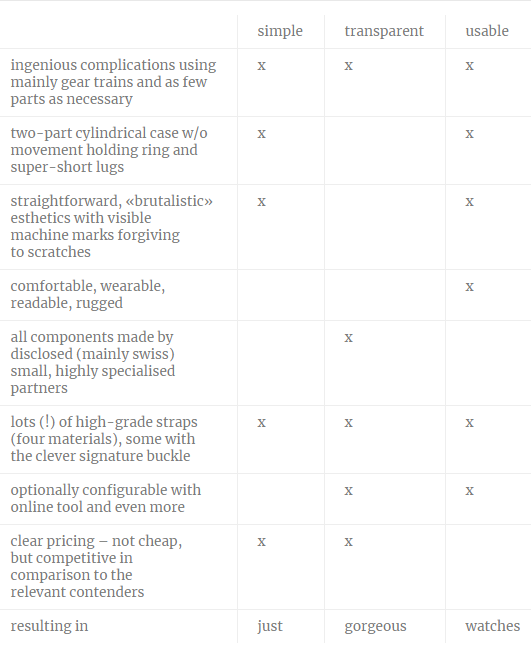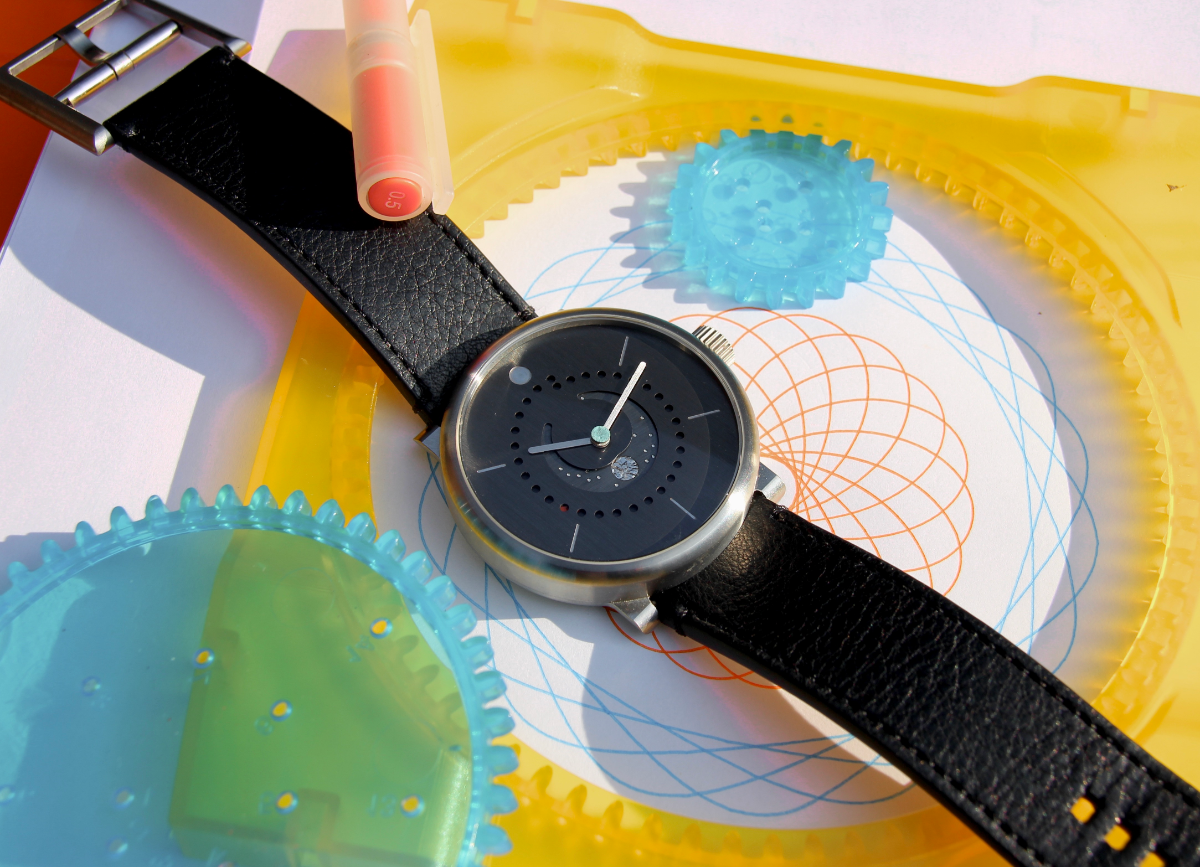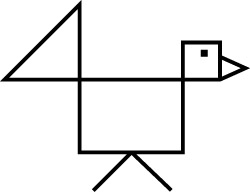Last year was a difficult year for most of us. The Coronavirus pandemic has brought many restrictions and suffering to the world. And as everyone knows most watch brands were hit hard by the virus, too: employees had to stay at home, suppliers could not deliver, customers stopped buying. From the large amount of difficulties within and outside the watch industry, I would like to draw attention here to a comparatively small detail: the various incidents which jumbled what is possibly the most uncompromising micro brand in the industry, ochs und junior.
End of 2019 – well before and independent from C19 – Beat Weinmann, co-founder and co-owner, left the company – and with him the whole team.
Beat was part of the story, long before it even began. Working at watch retailer Embassy fron Lucern he was part of the team, which brought the MIH-watch to life back in 2005.
For those of you, who don’t know: the MIH watch was the official watch of the «Musée international d’horlogerie» in La Chaux de Fonds, one of the most important museums of the horological world and is the brainchild of Dr. Ludwig Oechslin, Paul Gerber and the Designer Christian Gafner. The MIH watch offers an annual calendar (by Oechslin) and a monopusher chronograph (by Gerber) in a minimalistic design (by Gafner, but incorporating Oechslin’s ideas, i. e. the display of day-month-date in one row and the ultra short lugs, which you find on todays ochs und junior watches).
Beat is known as a marketing genius: tremendously structured, extremely committed and mastering off- and online-marketing equally well.
Many customers (and other market players) could not imagine a future of the company without him, who was regarded as a core of the brand and even as a friend.
I can only confirm this. I bought my first ochs und junior watch in summer 2018 and the whole process from the first contact, the various iterations on the way to finalise the individual designs, to the pick-up in Lucerne was just a blast.
So this “earthquake” led to a great deal of uncertainty among owners, potential clients and the market as a whole, to say the least. (Beat is now working for Chronoswiss in Lucerne.)
Therefore in 2020 – in addition to the impacts of COVID – ochs und junior also had hard times to sort themselves anew and to win back the trust of it’s customer base.
On top of this ochs und junior also worked on the final steps on new products (or rather product lines, see below) and moved its headquarters from Lucerne to La Chaux-de-Fonds. (One of the first rumors was, that this was done to get closer to co-owner Ulysse Nardin – this proved wrong, so much for speculations; again, see below.)
To guide the ship through these heavy seas, Marc Bernhardt joined as the new CEO and face to the customer.
From my personal view, this worked very well: I have gone through the order and delivery process of my second ochs und junior with him and it was as much fun as before.
He, however, left the company end of 2020 – and actually acted extremely professionally during his last days with the company, too, still promoting the company and it’s new strategy all the time.
They say “You buy the seller”, which has a lot of truth to it, but the core of a watch company remains … well … the watch.
So let’s shed a light on the core concept before looking at the changes in strategy:
The heart of ochs und junior is the combination of the ingenious solutions (most importantly I guess the complications using gear trains with as few parts as necessary) constructed by Dr. Ludwig Oechslin.
To me – and this is just my subjective perspective from outside the company – the brand core could be described as follows:

Ludwig Oechslin started his career in watchmaking by going into an apprenticeship at Jörg Spöring, a well known watchmaker (with whom he later did build one of the most complicated clocks of all times, the so called «Türler clock»).
During that time he got the job to restore a highly complicated clock from the early 18th century (owned by the Vatican), the farnese clock. As it happened, this clock “stands for a completely new way of watchmaking, in which complex rotation speed ratios are transferred to the dial displays” (Wikipedia, only in German) and was based on a system of gearwheels.
Apparently, this work, which is the basis of his doctoral thesis, seems to have influenced Oechslin’s entire oeuvre: complex astronomical and calendar displays implemented by means of straightforward and dependable gear trains.
While later also working on the restoration of traditional perpetual calendar watches, he looked for new solutions, that allowed the watch to be set forwards and backwards and to be more reliable.
In the following years he worked with Rolf Schnyder, the owner of Ulysse Nardin at the time. But since not all of Oechslin’s deliberately simple designs were of interest to Rolf Schnyder, only the most complex inventions (i. e. the «Freak») found their way into the Ulysse Nardin watches.
The first incarnation of his conceptions of super-simple yet sophisticated complications on the other hand was the a. m. MIH-watch, a watchmaking icon realised while Oechslin was the director of the MIH Museum.
A year later, these ideas led to the founding of his own watch company, ochs and junior.
Ochs und junior watches do not have a logo on the dial (or anywhere else) but still are as recognisable as some well knows icons of the industry.
The cases are in most cases made of grade 5 titanium, machined with extreme precision so that no further finishing is applied, resulting in a technical, raw, look. The case is two-part, the caseback houses the movement. (Due to it’s precision, no movement holder ring is required; also because of this construction a see-through-back is not possible.)
The lugs are unusually short, resulting in lug-to-lug-width which is the same as the diameter. Another typical design element of most ochs und junior watches is the date spiral, which uses 31 dots (which additionally serve as 2-minute-indices) to display the date graphically. This admittedly needs some familiarisation, but works surprisingly good and without the need of reading glasses (or a date loupe).
It all started with the simple Settimana, a colourful 36mm watch with week-day display, (which I admired from the start for whatever reason, but couldn’t afford), later they added models like the super-precise yet simple moonphase, the annual calendar or the «top model« the perpetual calender, which you can set forwards and backwards.
Besides the Oechslin inventions and constructions, ochs und junior is – to a lesser extent – known for the fact, that you can chose nearly every aspect of the design. Using the on-line configurator (or just the phone, if you want it even more special) the customer can choose from a bazingillion of combinations of dials, hands, indices, etc..
This is possible, as ochs und junior is a small brand, currently producing some 100-150 watches per year. Also most of the parts are individually made by small subcontractors or the small team in-house; this obviously leads to a pricing which can’t compete with mass-producing competition.
On the other hand, the ingenious complications of the movement (e. g. the perpetual calendar needs only 3 modified and 9 additional parts!) and the construction of the watch as a whole (e. g. no movement ring), is downright ideal for reducing complexity in production.
From this perspective, it seems quite logical, that ochs und junior wanted to offer also watches, which you can’t configure yourself, but are readily designed – and hence more affordable.
And while every design is a matter of personal taste, the designs for the new product lines are the brainchildren of very qualified new team members: Louise Krank, communication-designer and Christian Gafner, the guy who was involved in designing the MIH watch (as well as the Porsche Design Worldtimer P 6750 btw) at the time.
At time of writing there are three “predesigned” product lines: a perpetual (100 years, hence the name »calendario cent’anni») calendar for just over 15k SFR (excl. taxes), a limited version in three colour schemes of the settimana and three variants on the moonphase watch, all with a hammered gold/platinum sun/moon.
While I really like the designs of the Settimana and the CCA a lot … I personally just LOVE the new moon phase trilogy.
These watches mark the third phase of the company as ochs und junior describes it.
(Phase one was the founding in 2006 with the major stakeholders Kurt König, MD of Embassy and Dr. Oechslin with minority stakeholders Ms. Imesch and Beat Weinmann, in Phase 2 the shareholder structure changed, i. e. Kurt König stepped down and Ulysse Nardin stepped in.)
In todays phase three ochs und junior is solely owned by Dr. Oechslin and Ms Imesch and the «juniors» get part of the team.
That is, two of three children are in the process of getting involved into ochs und junior, Louise, the daughter-in-law of Mr Oechslin and Ms Imesch, being one of them.
So today ochs und junior’s portfolio is kind of based on two pillars, the «configurable models» (astronomicals, calendars and 2nd timezones) and the «standard», pre-configured, ones.
The latter being the Settimana Limited, the 36mm watch which started it all and the calendario cent’anni, a perpetual/100 years calendar visually designed by Christian Gaffner (which, compared to the configurable one, lacks the power reserve display (as it uses another Ulysse Nardin movement), but can also be set backwards and forwards!).
And, drawing from the pool of Oechslin’s developments, there is more to come …
Just to give you an idea of his «wackily» 😉 ideas: he is currently working on a «computus» watch, which marks the actual beginning of carnival, a date which – as it depends on Easter – changes every year sometime between February and March and hence needs not less than seven different interlaced algorithms to be calculated by means of gear wheels…
The concept of the watches of ochs und junior remains to stay strong and is now accompanied by a future oriented albeit new strategy. So continued success is more than likely.
I have a sweet spot for family businesses and young people coming aboard and I am looking forward to the next 15 years.
Epilogue
Yes, La Chaux-de-Fonds is not Lucerne.
No Lake, no Pilatus, no Kapellbrücke, no Culture and Congress Centre … and no herds of chinese tourists, either.
Located in the Swiss Jura and one of the highest cities in Europe (some 1.000m) it’s also considerably colder there.
But we are here for the watches! The «Musée international d’horlogerie» – with some 3.400 watches and clocks possibly the most important watch museum worldwide – is here, a must for watch-nuts like us.
And it’s also the home of many watch companies; traditional houses such as Girard Perregaux, TAG Heuer or Incabloc as well as more recent ones like La Joux-Perret, Concepto Watch or Lundis Bleus – and of several young start-ups!
And if this is not enough, other watch centres, such as Neuchâtel, Biel or Le Locle are just a stone’s throw away.
LCdF is also (together with nearby Le Locle) a UNESCO world heritage site due to it’s unique urban planning which follows the special requirements of a city, that has been characterised by watchmaking for centuries.
And it is the birth place of Le corbusier, key person of the brutalism (some watch aficionados compare the ochs und junior design with brutalism) … and has an art museum (featuring a Modigliani), too – in case you have to sell the visit to your partner.
I will (ok, for me it is comparatively easy to reach in less than five 5 hours by car) most definitely visit La Chaux-de-Fonds and the ochs und junior villa as soon as C-19 allows …
More:


Leave a Reply
You must be logged in to post a comment.